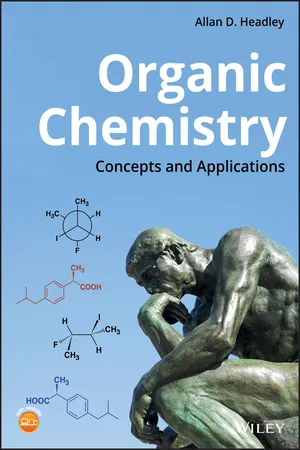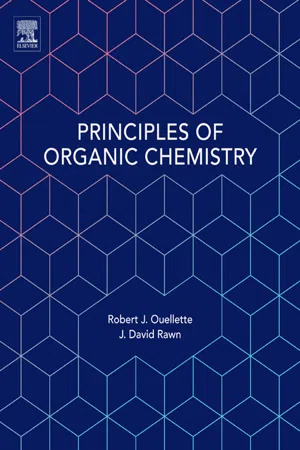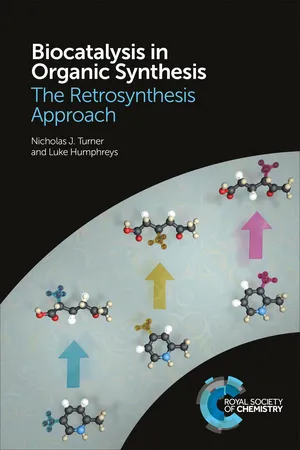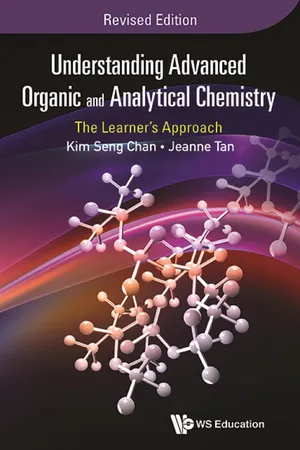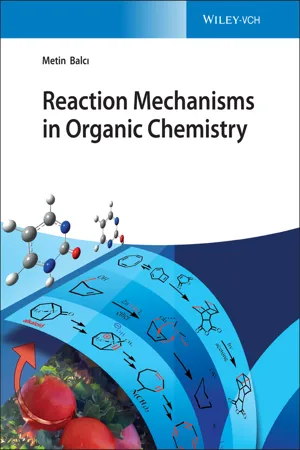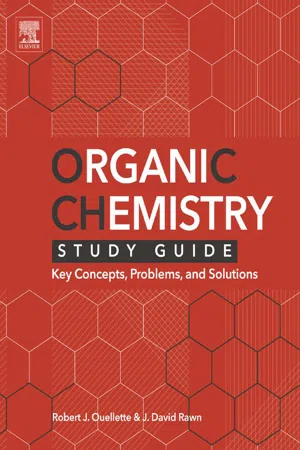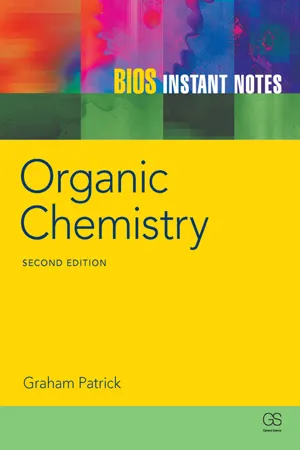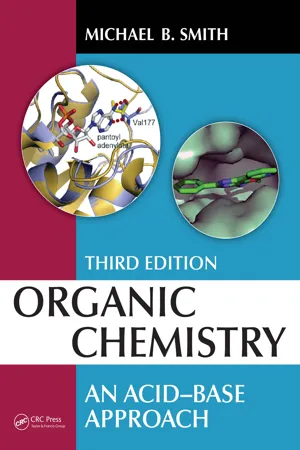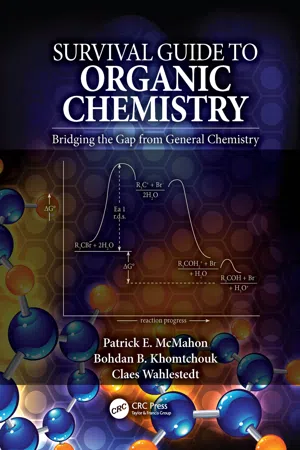Chemistry
Hydrolysis of Halogenoalkanes
The hydrolysis of halogenoalkanes involves the reaction of halogenoalkanes with water to form alcohols and hydrogen halides. This reaction is typically carried out in the presence of a strong nucleophile, such as hydroxide ions, which attack the carbon atom bonded to the halogen, leading to the substitution of the halogen with a hydroxyl group. The hydrolysis of halogenoalkanes is an important process in organic chemistry.
Written by Perlego with AI-assistance
Related key terms
Related key terms
1 of 4
Related key terms
1 of 3
11 Key excerpts on "Hydrolysis of Halogenoalkanes"
- eBook - ePub
Organic Chemistry
Concepts and Applications
- Allan D. Headley(Author)
- 2019(Publication Date)
- Wiley(Publisher)
Alkanes are fairly inert compounds; some alkanes are used as solvents to provide inert media for different reactions that we will see in later chapters. In addition to combustion, alkanes undergo another type of reaction that is very important to organic chemists, and that is the reaction with halogens, specifically chlorine or bromine in the presence of energy in the form of heat or light. As the name suggests, this reaction involves the reaction of alkanes and bromine or chlorine and is called bromination or chlorination of alkanes, respectively. These reactions are performed in the presence of light or heat and are described as substitution reactions since a hydrogen or more than one hydrogen atoms of an alkane reactant are substituted for a halogen or more than one halogen in the product. Most of the reactions that will be encountered in this chapter involve the substitution of one hydrogen in the alkane for a halogen in the product.The products produced upon the chlorination of alkanes are alkyl halides, most are important industrial raw material for the synthesis of numerous other chemicals. For example, chloromethane was used once as a refrigerant, but discontinued owing to its flammability and toxicity. Today, it is widely used as a chemical intermediate for the production of different compounds, including polymers. Other chloroalkanes are widely used as a solvent in the research labs and in the production of rubber and in the petroleum refining industry. The chlorination of methane is shown in Reaction (14‐5) .(14‐5)To be able to predict the products of these and other similar reactions, a thorough understanding of how the reaction occurs is essential. Before we examine the reaction mechanism for the chlorination of alkanes, let us examine the process of bond reorganization for the reaction shown in Reaction (14‐5) . It should be obvious that this reaction is a substitution reaction in which a Cl─Cl bond has to be broken and the chlorine atoms form two new bonds, a new H─Cl bond and a new C─Cl bond in the CH3 - eBook - ePub
- Robert J. Ouellette, J. David Rawn(Authors)
- 2015(Publication Date)
- Elsevier(Publisher)
7Nucleophilic Substitution and Elimination Reactions
7.1 Reaction Mechanisms and Haloalkanes
We introduced the concept of functional groups and their role in the organization of the structures of organic molecules in Section 1.9 . We described the importance of reaction mechanisms as an organizational device to classify chemical reactions in Section 2.9 . The details of the electrophilic addition reactions of alkenes (Section 4.9 ) and electrophilic substitution reactions of aromatic compounds (Section 5.5 ) are examples of two important reaction mechanisms. In this chapter we examine two more types of reactions mechanisms—nucleophilic substitution and elimination reactions. These mechanisms often occur in competition with one another and describe the reactions of several classes of compounds, such as haloalkanes (also called alkyl halides) and alcohols. In this chapter we focus on the substitution and elimination reactions of haloalkanes. These reactions illustrate the role of structure in determining the degree to which a given reaction mechanisms occurs.Reactivity of Haloalkanes
Haloalkanes have a halogen atom bonded to an sp3 -hybridized carbon atom. As a result of the greater electronegativity of the halogens, the carbon atom of the carbon-halogen bond bears a partial positive charge and the halogen atom has a partial negative charge.where X = F, Cl, Br, ISince a carbon-halogen bond is polar, a haloalkane has two sites of reactivity. One is at the carbon atom bonded to the halogen atom. This carbon atom is electropositive and reacts with nucleophiles. The second site of reactivity in a haloalkane is the hydrogen atom bonded to the carbon atom adjacent to the carbon atom bonded to the halogen atom. This hydrogen atom is more acidic than the hydrogen atoms in alkanes because the halogen atom on the adjacent carbon atom withdraws electron density by an inductive effect. - eBook - ePub
Biocatalysis in Organic Synthesis
The Retrosynthesis Approach
- Nicholas J Turner, Luke Humphreys(Authors)
- 2018(Publication Date)
- Royal Society of Chemistry(Publisher)
Figure 3.31 , we can also use nitrile hydratases to carry out kinetic resolution of nitrile substrates. In each case above, the faster reacting enantiomer of the substrate is shown. The mechanism of nitrile hydrolysis to the corresponding primary amide with nitrile hydratases is more complex and involves the use of a non-heme iron centre. The mechanism will not be discussed here, but more advanced readers are encouraged to carry out further research.3.6 Hydrolysis of Carbon–Halogen Bonds
The conversion of an alkyl halide to an alcohol would usually be achieved via a chemical substitution reaction with hydroxide as the nucleophile. The exact mechanism (SN 1 or SN 2) is dependent on the substitution pattern of the substrate. However, carrying out a substitution reaction under chemical conditions can result in racemisation if the halogenated substrate is chiral. As shown in Figure 3.32 , there are also enzymes that are capable of hydrolysing carbon–halogen bonds, called haloalkane dehalogenases.Figure 3.32 General transformation catalysed by haloalkane dehalogenases.Enzymes capable of this transformation have been discovered in microbes living in soil contaminated with alkyl halides. These microbes use halogenated compounds as a carbon source for growth, requiring them to remove the halides from these compounds before utilising them further. Haloalkane dehalogenases have been reported to act on a wide variety of halogenated substrates, as shown in Figure 3.33 , although only at sp 3 hybridised carbons. In each case, the product alcohol is shown.Figure 3.33 Substrate scope of alkyl halides hydrolysed by haloalkane dehalogenases.Kinetic resolution reactions can be carried out with haloalkane dehalogenases, as shown in Figure 3.34 . In this case, we end up with the product alcohol and the remaining haloalkane being homochiral (the same configuration). This is because the reaction proceeds with inversion of the configuration, just like an SN 2 reaction. So for each example in Figure 3.34 - eBook - ePub
Understanding Advanced Organic and Analytical Chemistry
The Learner's ApproachRevised Edition
- Kim Seng Chan, Jeanne Tan;;;(Authors)
- 2016(Publication Date)
- WS EDUCATION(Publisher)
This reaction is also known as alkaline hydrolysis, which is carried out in an aqueous medium. And because of the possibility of reaction between halogenoalkanes and hydroxide, PVC containers, made of none other than polyvinyl chloride (or poly(chloroethene)), cannot be used to contain the alkaline solution. In addition, this alkaline hydrolysis reaction can serve as an important way to distinguish between halogenoalkanes containing Cl, Br or I.Q:Can the water molecules in the aqueous medium act as a nucleophile?A:Yes, the lone pair of electrons of the water molecule can make it a nucleophile. But unfortunately, it is not as good a nucleophile as compared to the hydroxide ion as the latter is negatively charged, and thus more electron-rich. Hence, PVC can be the material for a water container.Q:Does it mean that if 1,1-dichloroethane underwent nucleophilic substitution with aqueous KOH, a diol would be obtained?A:No, you would not get the following geminal diol:The germinal diol would undergo spontaneous dehydration to give the aldehyde (CH3 CHO), expelling a water molecule in the process. This would also mean that if 1,1,1-trichloroethane reacts with aqueous NaOH, we would not get the following germinal triol, but the carboxylic acid (CH3 COOH) instead.Example 7.1: Describe a chemical test to distinguish between chloroethane, bromoethane and iodoethane.Solution:Test: Add NaOH(aq) to each of these compounds and heat. Next, cool the mixture followed by adding HNO3 (aq). Lastly, add AgNO3 (aq).Rationale: When NaOH(aq) is added, the halogenoalkanes undergo hydrolysis. This reaction releases halide ions into the solution. With the silver nitrate added, the halide ions form insoluble silver halide salts that can be identified by their different color, and a conclusion can be made on the type of halogenoalkane present.Ag+ (aq) + X– (aq) —→ AgX(s)Take note that halogenoarenes do not undergo hydrolysis unless under extreme conditions. Reasons are discussed in Section 7.6 .Q:What is the purpose of cooling the mixture and adding HNO3 (aq) before the addition of AgNO3 (aq)?A:Cooling is needed to prevent AgNO3 from decomposing since it is thermally unstable. The acidification using HNO3 is to remove the excess NaOH. If not, when AgNO3 is added, Ag(OH) may be precipitated out. Using HNO3 instead of HCl or H2 SO4 for acidification prevents introducing anions into the system that may be precipitated out by the Ag+ - eBook - ePub
- Metin Balc?, Metin Balc?, Metin Balc?, Metin Balc?, Metin Balc?(Authors)
- 2021(Publication Date)
- Wiley-VCH(Publisher)
2 O. The reaction proceeds according to Markovnikov's rule. The proton adds to the less substituted carbon atom, while the alkoxy group adds to the more substituted carbon atom. There is no stereospecificity associated with this reaction because the intermediate formed is a carbocation, which can be attacked from both faces of the planar carbocation.4.3.3 Formation of Halohydrins
When alkenes react with halogens in non-nucleophilic solvents such as carbon tetrachloride and chloroform, they produce vicinal 1,2-dihalides. If the reaction is performed in a nucleophilic solvent such as water, the solvent becomes the nucleophile in the second step and reacts with the halonium ion to form halohydrins.As the halogen approaches the alkene, the π-bond electrons will repel the electrons in the halogen–halogen bond, leaving the nearer halogen slightly positive as shown below. First, a cyclic halonium ion is formed because the halogen is the only electrophile. The halogen accepts the π-bond electrons from the double bond and forms a bromonium (or chloronium) ion. The unstable cyclic halonium ion rapidly reacts with the nucleophile, water, because it is present in a much higher percentage than the halide anion. An anti-stereoselectivity is observed during the addition because the solvent approaches the halonium ion from the back. For example, the addition of bromine to cyclopentene in the presence of water gives trans-2-bromocyclopentanol.If the halonium ion formed has a symmetrical structure, the nucleophile attacks both carbon atoms with the same probability. However, if the halonium ion is not symmetrical, a regioselectivity is observed by the same mechanism we used to rationalize Markovnikov's rule. When propene reacts with bromine and water, the major product has the electrophile bonded to the less substituted carbon atom of the double bond, while the hydroxyl group is bonded to the more substituted carbon atom. - eBook - ePub
- Andrew F. Parsons(Author)
- 2013(Publication Date)
- Wiley(Publisher)
5 HalogenoalkanesKey point . Halogenoalkanes (RX) are composed of an alkyl group bonded to a halogen atom (X = F, Cl, Br or I). As halogen atoms are more electronegative than carbon, the C–X bond is polar and nucleophiles can attack the slightly positive carbon atom. This leads to the halogen atom being replaced by the nucleophile in a nucleophilic substitution reaction and this can occur by either an SN1 (two-step ) or SN2 (concerted or one-step) mechanism . In competition with substitution is elimination , which results in the loss of HX from halogenoalkanes to form alkenes. This can occur by either an E1 (two-step ) or E2 (concerted ) mechanism . The mechanism of the substitution or elimination reaction depends on the structure of the halogenoalkane, the solvent and the nucleophile/base.5.1 Structure
Halogenoalkanes, R–X, have an alkyl group (R) joined to a halogen atom by a single bond. The larger the size of the halogen atom (X = I > Br > Cl > F), the weaker the C–X bond (Appendix 1). With the exception of C–I, the C–X bond is polar; the carbon atom bears a slight positive charge and the electronegative halogen atom bears a slight negative charge.The use of hashed and wedged line notation is discussed in Section 3.3.2 Hybridisation is introduced in Section 1.5 Naming halogenoalkanes is discussed in Section 2.4Halogenoalkanes have an sp3 carbon atom and so have a tetrahedral shape.- An aliphatic halogenoalkane has the carbon atoms in a chain and not a closed ring, e.g. 1-bromohexane, CH3 (CH2 )5 Br.
- An alicyclic halogenoalkane has the carbon atoms in a closed ring, but the ring is not aromatic, e.g. bromocyclohexane, C6 H11 Br.
- An aromatic halogenoalkane has the carbon atoms in a closed ring and the ring is aromatic, e.g. bromobenzene, C6 H5
- eBook - ePub
Organic Chemistry Study Guide
Key Concepts, Problems, and Solutions
- Robert J. Ouellette, J. David Rawn(Authors)
- 2014(Publication Date)
- Elsevier(Publisher)
Also, electronegative substituents near the carbon atom bearing the hydroxyl group increase its acidity. Halogen substituents inductively withdraw electron density from the oxygen atom and weaken the O—H bond. The halogens also stabilize the negative charge of the conjugate base—an alkoxide ion.Alcohols, like water, can be protonated. The product is a conjugate acid known as an alkyloxonium ion.9.12 Substitution Reactions of Alcohols
The hydroxyl group of alcohols react with hydrogen halides such as HBr to give haloalkanes. The order of reactivity is tertiary > secondary > primary. Hydrogen bromide suffices to form bromoalkanes, but zinc chloride is required as a catalyst for the reaction with hydrogen chloride. The substitution reactions of alcohols parallel that of haloalkanes. However, hydroxide ion is not the leaving group. Protonation of the hydroxyl group must occur to allow water to become the leaving group. In general, a weaker base is a better leaving group than a stronger base. Since hydroxide ion is a stronger base than water, it is a poor leaving group in both SN 1 and SN 2 reactions.The order of reactivity of alcohols in SN 1 reactions is tertiary > secondary > primary. This order parallels the stability of the carbocation intermediates that form in the reaction. This order of reactivity is reversed for SN 2 reactions; however, tertiary alcohols do not react by an SN 2 mechanism.9.13 Alternate Methods for the Synthesis of Alkyl Halides
Since undesirable rearrangements occur in acid-catalyzed reactions of alcohols, other methods have been developed to synthesize alcohols that do not require acid. In this section, we discussed two additional reagents that convert alcohols to haloalkanes. They are used for secondary and primary alcohols which react slowly with hydrogen halides.Thionyl chloride is used to convert alcohols to chloroalkanes. The by-products are sulfur dioxide and hydrogen chloride, both of which escape from the solution as gases. Phosphorus tribromide is used to convert alcohols to bromoalkanes. The by-product, phosphorous acid, is soluble in water. - eBook - ePub
- Graham Patrick(Author)
- 2004(Publication Date)
- Taylor & Francis(Publisher)
SECTION L — ALKYL HALIDESL1 Preparation and physical properties of alkyl halides
Key Notes
Preparation Alkenes are converted to alkyl halides by reaction with hydrogen halides. Treatment with halogens results in dihaloalkanes. Tertiary alcohols can be converted to alkyl halides on treatment with hydrogen halides, whereas primary and secondary alcohols are best converted by using thionyl chloride or phosphorus tribromide. Structure Alkyl halides consist of an alkyl group linked to a halogen. The carbon linked to the halogen is sp 3 hybridized and tetrahedral. The carbon–halogen bond length increases and the bond strength decreases as the halogen increases in size. Bonding The C–halogen bond (C–X) is a polar σ bond where the halogen is slightly negative and the carbon is slightly positive. Intermolecular bonding is by weak van der Waals interactions. Properties Alkyl halides have a dipole moment. They are poorly soluble in water, but dissolve in organic solvents. They react as electrophiles at the carbon center. Reactions Alkyl halides undergo nucleophilic substitution reactions and elimination reactions. Spectroscopic analysis The presence of a halogen atom can be shown by IR spectroscopy (C–X stretching absorptions) as well as by mass spectrometry. The latter shows a characteristic pattern of peaks for the molecular ion that matches the number and ratio of naturally occurring isotopes of the halogen. Elemental analysis also demonstrates the presence of halogens. Related topics (A3) sp 3 Hybridization (C3) Intermolecular bonding (C4) Properties and reactions (H3) Electrophilic addition to symmetrical alkenes (M4) Reactions of alcohols (P3) Infra-red spectroscopy (P4) Proton nuclear magnetic resonance spectroscopy (P6) Mass spectrometry Preparation
Alkenes can be treated with hydrogen halides (HCl, HBr, and HI) or halogens (Cl2 and Br2 ) to give alkyl halides and dihaloalkanes respectively (Section H3 ). An extremely useful method of preparing alkyl halides is to treat an alcohol with a hydrogen halide (HX = HCl, HBr, or HI). The reaction works best for tertiary alcohols (Section M4 ). Primary and secondary alcohols can be converted to alkyl halides more effectively by treating them with thionyl chloride (SOCl2 ) or phosphorus tribromide (PBr3 - John Whittall, Peter W. Sutton, John Whittall, Peter W. Sutton(Authors)
- 2012(Publication Date)
- Wiley(Publisher)
The hydrolytic replacement of a halide by hydroxyl functionality takes place in a stereospecific manner 1. The haloalkane dehalogenases are applicable in asymmetric biocatalysis since haloalkanes and alcohols are valuable building blocks in organic synthesis. 1–3 The kinetic resolution of a wide range of racemic brominated substrates was performed with four haloalkane dehalogenases: DhaA from Rhodococcus rhodochrous NCIMB 13064, LinB from Sphingobium japonicum UT26, DbjA from Bradyrhizobium japonicum USDA 110 and DatA from Agrobacterium tumefaciens C58. The gram-scale synthesis has been demonstrated during enzymatic preparation of optically pure (S)-2-bromopentane by kinetic resolution of racemic 2-bromopentane using the haloalkane dehalogenase DbjA. 4 Figure 11.2.1 Reaction mechanism of α-bromoesters (a) and β-bromoalkanes (b) conversion catalyzed by the haloalkane dehalogenases. 11.2.1 Procedure 1: Kinetic Resolution of α-Bromoesters and β-Bromoalkanes 11.2.1.1 Materials and Equipment - Tris(hydroxymethyl)aminomethane (Sigma-Aldrich) - Halogenated substrates (Sigma-Aldrich) - Diethyl ether (Chromservis) - Anhydrous sodium sulfate (Sigma-Aldrich) - Haloalkane dehalogenase enzymes (Enantis) - 25 mL Reaction vessels with screw cap (Pierce Chemical) - Microliter syringes (Hamilton), glass tubes with screw cap (Sigma-Aldrich) - Pasteur pipettes (Hirschmann Laborgerate) - Chromatography crimp top vials (Chromacol) - Gas chromatograph HP 6890 equipped with flame ionization detector (Hewlett Packard) - Capillary GC columns Chiraldex G-TA and B-TA (Alltech) 11.2.1.2 Procedure 1. Kinetic resolution was performed at room temperature (21 °C) in screw-capped reaction vessels- eBook - ePub
Organic Chemistry
An Acid-Base Approach
- Michael B. Smith(Author)
- 2022(Publication Date)
- CRC Press(Publisher)
not the only solvent that will facilitate ionization, but the rate of solvolysis reaction varies greatly. Indeed, solvolysis is usually slow if water is not present, but it can occur given sufficient time.- 11.15. Write out the mechanism for reaction of ethanol with 4-bromo-3-ethyl-3-methylhexane and then the acid-base reaction of the resulting oxonium salt with ethanol to produce 3-ethoxy-3-ethyl-4-methylhexane.
11.5 Substitution Reactions of Alcohols
The leaving group used most often in substitution reactions is the halogen of an alkyl halide, which are readily prepared from alcohols. In the discussions of both SN 1 and SN 2 reactions, the OH unit is a very poor leaving group and nucleophiles do not react directly with an alcohol via an SN 2 reaction. Therefore, the OH unit must be converted to a good leaving group for substitution reactions. Alcohols can be converted to sulfonate esters, which are good leaving groups (Section 11.1) but this reaction will not be described until Sections 18.3,6.11.5.1 Alcohols React with Mineral Acids
Alcohols React H—X AcidsThe reaction of an alcohol with a suitable acid converts the R–OH unit (a poor leaving group) to R–OH2 + , an oxonium ion intermediate that is essentially a water molecule bound to an alkyl group. Water is a stable and neutral molecule and therefore a good leaving group, ROH2 + . When butan-1-ol was treated with 48% HBr, in the presence of H2 SO4 , a 95% yield of 1-bromobutane was obtained.8 When 2-methylpropan-2-ol (tert-butyl alcohol) was treated with concentrated HCl, 2-chloro-2-methylpropane (tert-butyl chloride) was isolated in 90% yield.9 In both reactions, the alcohol first reacts with HCl to form an oxonium ion, as shown in Figure 11.8 , along with the halide counterion of the acid (the conjugate base). The oxonium ion 14 derived from butan-1-ol is a primary system. Ionization to a primary cation is very slow but an SN 2 reaction with the bromide counterion rapidly gives 1-bromobutane. The oxonium ion 15 is derived from a tertiary alcohol and it ionizes in the protic medium to give a tertiary carbocation via loss of water. Once formed, a rapid SN 1 reaction with the nucleophilic chloride ion gives 2-chloro-2-methylpropane. Secondary alcohols may react by both the SN 2 and the SN 1 pathway, depending on the solvent. If an SN - eBook - ePub
Survival Guide to Organic Chemistry
Bridging the Gap from General Chemistry
- Patrick E. McMahon, Bohdan B. Khomtchouk, Claes Wahlestedt(Authors)
- 2016(Publication Date)
- CRC Press(Publisher)
and H 2 PO 4−2) are selected for desired elimination.- Summary: (R = C or H )
12.5.2 REACTION ANALYSIS FOR ALKYL HALIDES
- Elimination and nucleophilic substitution reactions in alkyl halides proceed through a common intermediate for the uni-molecular reactions (SN1 and E1 ):
- The common intermediate is the carbon cation R3 C+ .
- The carbon cation can undergo elimination (alkene formation) or nucleophilic substitution (e.g., formation of an alcohol or ether product from water or alcohol). The solvent (e.g., water or alcohol) often acts as both the nucleophile or weak base (solvolysis ).
- The unimolecular set of reactions for alkyl halides require conditions of relatively stable carbon cation formation and no strong base: SNl and El will occur simultaneously for tertiary alkyl halides under weak base/neutral conditions .
- Elimination can always be favored over substitution at higher temperatures; SNl (substitution ) can rarely be favored for alkyl halides and has limited usefulness.
- Summary Example: (R = C or H; but alkyl halide is usually tertiary ) ROH = water or alcohol:
- The bimolecular mechanisms, E2 and SN2 , do not proceed through a common intermediate for alkyl halides . However, both products can be formed simultaneously whenever conditions for substitution
Index pages curate the most relevant extracts from our library of academic textbooks. They’ve been created using an in-house natural language model (NLM), each adding context and meaning to key research topics.
Explore more topic indexes
Explore more topic indexes
1 of 6
Explore more topic indexes
1 of 4
